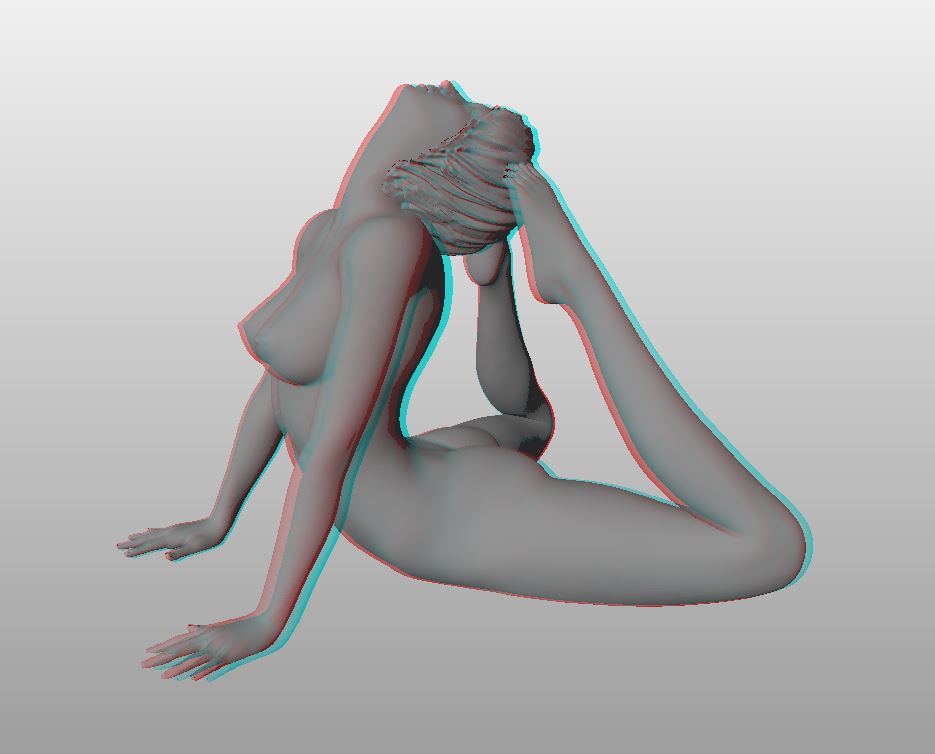The second new print was inspired by one of the many great pictures I came across in Bella Donna's Tumblr blog. I should warn you that it is NSFW, but it is a beautifully curated collection.
This is one one of many archive photos and sadly there are no details of the photographer. Performing a Google image search didn't help me on this occasion.
There are many invisible details that I have had to use my imagination for, such as the position of the feet in relation to the head and the expression on the model's face. It was a great challenge though and resulted in a nicely printable model.
Here's a side view of my digital version in red-cyan anaglyph mode (which I've just discovered you can do in NetFabb!). Dig out those glasses and have a preview.
This model just happens to be close to the exact proportions of my printer's printable volume, so this could turn out to be one of my largest models yet. At a layer height of 0.1 mm and a total print height of 125 mm this is going to take 18 hours to print. Keeping everything crossed for this one!
OK, printing successfully finished and here she is (iPhone included for scale).
Here is the first of three new prints I have been working on recently.
'Reflections' came to my attention when Bruno Birkhofer posted a different picture on Google+ last week. All his pictures are beautiful but, once again, it was one of his black and white portraits that inspired me to try another sculpture.
Modelling the pose in my favourite character modelling program was fun, as usual, but it proved particularly tricky to place the hands in exactly the right position. Several of the joint movement ranges have to have their range limitations turned off just to get close.
In a moment of over-zealous optimism I decided to replicate the model's facial expression and kept the eyes closed but the mouth open. This involved a significant amount of cleaning up in Blender for a detail that ultimately proved too small to show in the final print.
Not to worry - one day I may be able to sell these models and perhaps I'll even be able to afford a nice high-resolution DLP printer like the Kudo3D and then they will look even better.
I'm now getting the hang of using Simplify3D to slice my models so that the support material is placed where it's needed. The only thing I got wrong this time was placing insufficient support underneath the ponytail. The tip broke free during printing but fortunately the print managed to correct itself leaving enough to look reasonably OK.
Here's a couple of photos of the final print using translucent coffee-coloured PLA from 3D Filaprint, at 0.1 mm layer resolution with support enabled.
Close-up reproducing the pose in Reflections
The full model, showing a nice reflection of its own
Another new pose inspired by this photo I found on Pinterest. The original photograph was taken by Mikhail Nekrasov.
(UPDATE - see Mikhail's comment below)
Character posing software really seems to struggle with extreme shoulder positions and this one was no exception.
I wanted to use Simplify3D again to make use of the excellent support material it generates. However, importing the finished model processed in Blender seemed to show artefacts generated by the eyes and mouth. Cura's Fix Horrible option still does a better job than Simplify 3D in this regard but unfortunately there is no function to export a 'fixed' file.
My standard solution in the past would have been to use Project Miller, the great experimental tool from Autodesk Labs, but it expired and ceased to work on 1st April 2014. Not funny!
Just on the off-chance, I reset my PC's clock to Feb 2014 and started the program up again. Bingo! It works perfectly. I fixed the model, exported a new STL file and loaded it up into Simplify3D. The new gcode looks clean as a whistle. Ready to start printing.
After a 12 hour printing run the print quality is already looking great.
This black ABS plastic always looks nice after smoothing with acetone vapour. Some of the horizontal banding caused by the print layers can become a bit more prominent though, so after breaking away all the support material I decided to try something new and gave the whole model a light sanding with a fine grit sandpaper first.
For models like this, I recommend doing the acetone vapour treatment in two halves. Holding the upper half of the model, I gently lowered the legs into the vapour for about 20 seconds and then set it aside to harden on a ceramic tile. Once the surface was hard to the touch several minutes later, I held the model upside down in the vapour and treated the head and body the same way.
This method gives a nice even smoothing without risking melting the lowest parts into a puddle of sludge.
And here's the original again. How did I do?










.JPG)
.JPG)
.JPG)
.JPG)





